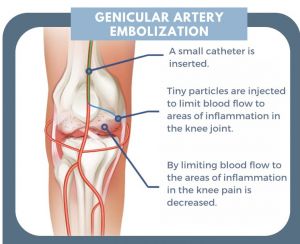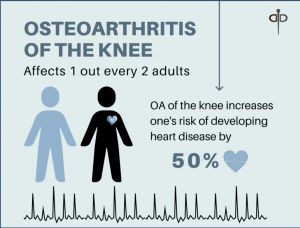Are There Genicular Artery Embolization Side Effects?

Are you living with the painful symptoms associated with osteoarthritis (OA) of the knee? You may have even tried to alleviate your discomfort with treatment methods like surgical procedures or medications to no avail. If so, a minimally invasive alternative treatment option available to combat osteoarthritis (OA) of the knee is genicular artery embolization. During this procedure, a vascular specialist redirects blood flow in the knee to alleviate painful symptoms. Genicular artery embolization is not only less aggressive than surgery, but also completed in an outpatient setting. All the benefits associated with this procedure make it extremely attractive to patients seeking treatment for OA of the knee, but are there any downsides? To learn more about any genicular artery embolization side effects, keep reading!
What is Genicular Artery Embolization?
Genicular artery embolization, or GAE, is a minimally invasive method of treatment for osteoarthritis (OA) of the knee. At Pedes Orange County, a Vascular Specialist will perform this procedure in an outpatient setting. To begin, our medical team will administer local anesthesia through your IV. You will be awake but feel no pain. After you are comfortably sedated, the Vascular Specialist will make a small needle puncture in your leg. Then, they will guide a catheter into the blood vessels that supply blood to your knee joint using X-ray image guidance. Once the catheter is in place, the Vascular Specialist will inject tiny, biologically compatible beads into the lining of your knee. The newly regulated blood flow will reduce the pain and swelling associated with OA of the knee.
What are the Benefits of Genicular Artery Embolization?
Compared to other methods of treatment for osteoarthritis of the knee, GAE has many benefits. For example, knee replacement surgery is a serious surgery and requires a hospital stay. Additionally, recovery times for knee replacement surgery are much longer, taking anywhere from six months to one year. On the other hand, a genicular artery embolization allows patients to leave that same day and the recovery process will typically take a few weeks. However- just like any other procedure, patients who undergo a genicular artery embolization may experience a few, minor side effects related to genicular artery embolization.
Are There Side Effects?
Research has shown that there are no significant side effects associated with genicular artery embolization. Any side effects patients report after their GAE procedure are minimal, well tolerated, and typically dissipate within a few weeks. Common side effects may include dull pain, numbing, bruising, and discoloration around the knee after the procedure. However, all side effects of genicular artery embolization resolved on their own. Its minimal side effects are not the only benefit to a genicular artery embolization. Additionally, the GAE procedure maintains a high success rate in reducing the painful symptoms associated with OA of the knee. In fact, up to 70% of patients who undergo GAE as a treatment method of OA of the knee have reported symptomatic relief after their procedure.
Are You a Candidate for Genicular Artery Embolization?
In appropriate patients, GAE is an alternative option for those who do not wish to undergo or are ineligible for knee replacement surgery and have failed to see benefits from other treatment options. GAE is not a cure for osteoarthritis, but patients experience an increase in quality of life as it reduces the symptoms of OA and the dependency on medications, injections, and therapy.
A genicular artery embolization is minimally invasive, effective, and does not cause any serious side effects. Any side effects that patients do report are well tolerated, and will most likely disappear on their own. Long-term joint relief can put miles back into your stride. Contact our office today if you think GAE is right for you.












